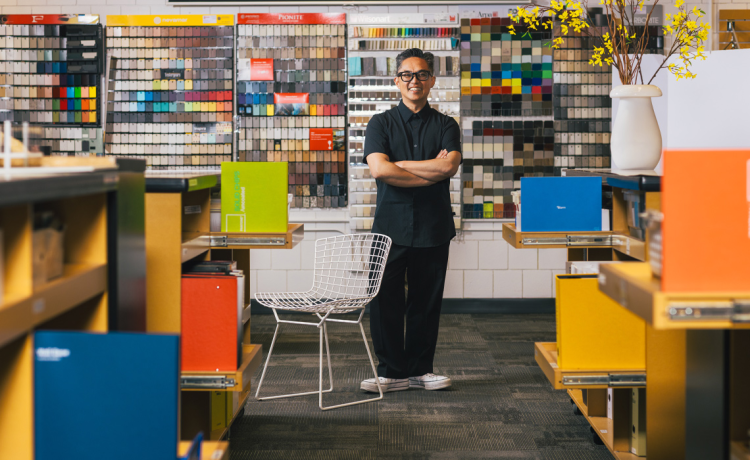The unconventional path from a biological sciences undergraduate degree to a career in interior design and architecture is proof of the creative mind's endless ability to keep reaching beyond.
That is the route of Associate Professor Alan Antioquia's education and subsequent occupation. Now chair of MRU's Department of Interior Design, Antioquia says he is where he is now because he began to listen to himself and his gut.

Associate professor and department chair Alan Antioquia encourages creative growth as students bring their design projects to life.
Antioquia's first degree is a Bachelor of Biological Science with a major in zoology from the University of Calgary. What he loved about zoology was dissection and studying the anatomy and morphology of animals. To complement that interest he took several art classes, and continues to create personal pieces today.
"I knew that I needed drawing and art to be part of my life if I was going to enjoy what I did," he says. "So I was still confused after four years and I knew I wasn't going to go and continue on with school in that field."
He was working part time at Eddie Bauer while a student, with which he continued on full time after graduating.
"I became a manager and really delved into retail and then retail merchandising. I helped open up new stores in Calgary and around the country and that became the impetus for loving design and merchandising and all of those creative things."
With his heart and mind set on working at the corporate office, designing and building stores, Antioquia was advised by a colleague that he would need a design degree. Serendipitously, that colleague had just finished taking interior design at Mount Royal and highly recommended the program.
"I met the faculty here and went and applied. I was in my early '30s, so I was a mature student, and graduated with an applied degree in 2003 knowing that I would eventually go build and design retail stores and restaurants. That was my passion and I did that for a number of years."
Antioquia kept in touch with the full-time faculty members from Mount Royal and planted the seed that he would love to come and teach part time at his alma mater. He would eventually receive an offer to do exactly that, and in 2007 began his teaching career as part of the contract faculty.
"I knew I'd eventually be in academia, but anticipated it being further on in my life. I knew I needed to eventually get a master's."
In 2011 Antioquia entered the University of Calgary to complete a Master of Architecture. Afterward, he continued with part-time teaching at Mount Royal and also kept on working in the industry until the call came out for a full-time position. It was 2015, and Antioquia applied, got the job, and started at the same time as MRU's new Bachelor of Interior Design was launched. He jumped in, helping to design lectures and develop the new program.
"It was very naive of me to think I could help develop a four-year program with no experience in curriculum development, but with lots of hard work, long nights and great guidance from faculty, it was really enjoyable."
More than meets the eye
A client-based field, interior design requires the ability to communicate at high levels.
"The most difficult projects are the ones where communication breaks down."
Antioquia says there are communications courses built into the curriculum in order to assist students in listening actively and understanding client needs, developing clear verbal communication for presenting designs and cultivating strong written skills for contracts and specifications.
In addition, "Interior designers have to be aware that clients may not be able to express their needs and wants. They don't have the design vocabulary that we have. So, we as designers have to be very in tune and aware of not just what they're saying, but also their body language."
It's often beneficial to go directly to design sites, such as a kitchen, and observe the nonverbal cues of how the client is navigating through their space, Antiquia says. It's up to the designers to be "investigators," and inquire if what was said was actually what was meant. There can be a lot of back-and-forth, for which patience is a requirement, however it's worth it to ensure the best possible final product.
Interior design as a profession is often misunderstood as merely decorating choosing colours, furniture and decor. In reality, it is much more than that. Its study involves a focus on functionality, life safety, building codes and the deep psychological impact of space. It requires technical knowledge, spatial planning, and a solid grasp of human behaviour within the built environment, making it far more than just aesthetics.
"It's surprising for most to understand that a large part of the job is to ensure the designs are safe, accessible and functional for people. In addition to creating functional and beautiful spaces, our students are eventually able to create construction drawings that contractors and their subtrades need to build our designs. That is why I love this profession, it is both creative and technical."
Interior designers' scope of work is focused primarily on the interior parts of a building. Addressing the functionality, aesthetics and user experience, they collaborate with other professionals such as architects, mechanical engineers, and electrical engineers to ensure that interior design elements integrate with the building's overall design and technical systems.
"We teach students the different types of wall construction, material and furniture selection, detailing and all of the millwork. All of that is included in our scope of work. You have this creative side, but you also need to have a technical side, which is quite exciting in the profession."
Progression towards the ultimate created reality
From 2014 to 2015, in preparation for transitioning from an applied to a four-year degree, Mount Royal's interior design studios and offices were entirely renovated. Each student gets their own space in the studio and a storage locker, there is a larger space available for more substantial projects, plus a sample library. Students learn to communicate their design though hand drawing, model building, AutoCAD, Revit, SketchUp, and all of the Adobe Creative Suite, such as Indesign, Illustrator and Photoshop.
The program is accredited through the Council for Interior Design Accreditation, with graduates meeting the educational requirements for eligibility to sit for the National Council for Interior Design Qualification Examination.
The curriculum Antioquia helped create takes students through several carefully curated steps.
"In the first years we are really getting them to start to understand how to ask questions and observe how people live and move through spaces. So, for example in residential design, we develop students' skills in understanding how much space is required to walk down a corridor, or from the kitchen island to the sink, the heights of cabinets, where showers should go in bathrooms, and so on. "
The first semester is called Space and Experience, and the students' first steps are investigating and gathering information about how humans experience spaces and the requirements necessary for human inhabitation.
"These are abstract concepts to understand how we meet all the criteria that the client wants, and also to make a space that actually works."
Students also come to understand what it actually means when someone requests something like a quiet, relaxing space. Or a space to work. Or a space to work out, or a space to sleep.
"We have a thematic approach for every semester. These themes are addressed across the course of that semester. Therefore, providing students with the opportunity to integrate, experiment and demonstrate their understanding through projects and exercises.
"I love the light-bulb moments when they go, I get it. That's why we were doing what we did in the first year.' And so, for me, that's exciting. You really need to get through all the way to the fourth year to understand the big picture. And sometimes it may even take until they start to practise and work. They live a lot of times in the gray area' of design, and that is ok, they eventually trust in their process and it becomes clear."
Antioquia holds end-of-year interviews with five or six students from each year at and asks them what they thought about their classes, which were their favourites, which could be improved upon, what assignments were most impactful, how the facilities worked for them and so on. Their feedback is then incorporated back into the curriculum, allowing for continuous improvement.
The result is a powerhouse crew of prominent graduates involved in some of the most creative and impactful projects in the city.
"It's awesome to go down 17th Avenue and past many of these really amazing restaurants and be able to name the graduates who designed them.
"They're loving what they're doing and they're making our communities better. That's gratifying."










